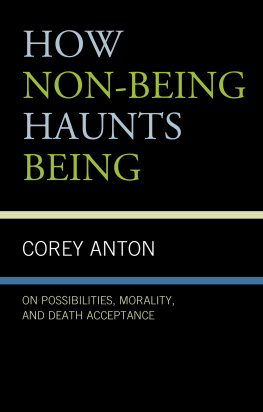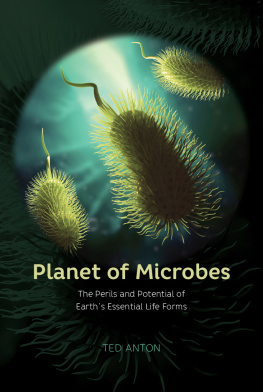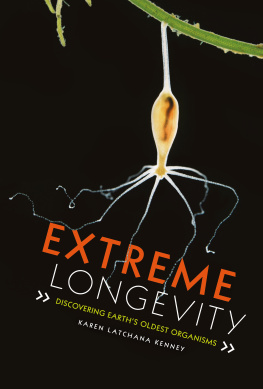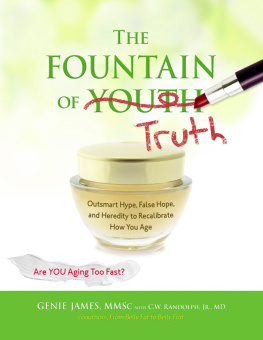THE LONGEVITY SEEKERS
Science, Business, and the Fountain of Youth
TED ANTON
THE UNIVERSITY OF CHICAGO PRESS
CHICAGO AND LONDON
Ted Anton is professor of English at DePaul University. He is the author, most recently, of Bold Science and has written for Chicago magazine, the Chicago Tribune, and Publishers Weekly.
The University of Chicago Press, Chicago 60637
The University of Chicago Press, Ltd., London
2013 by Ted Anton
All rights reserved. Published 2013.
Printed in the United States of America
22 21 20 19 18 17 16 15 14 13 1 2 3 4 5
ISBN-13: 978-0-226-02093-8 (cloth)
ISBN-13: 978-0-226-02095-2 (e-book)
Library of Congress Cataloging-in-Publication Data
Anton, Ted.
The longevity seekers : science, business, and the fountain of youth / Ted Anton.
pages. cm.(From obscurity, 19802005Greater than the double helix itself, 19801990The grim reaper, 19911993Sorcerers apprentices, 19911996Race for a master switch, 19892000Money to burn, 20002003Longevity noir, 20032004Betting the trifecta, 20052006Defying gravity: the battle to find a drug for extending health, 20052013Sex, power and the wild: the evolution of aging, 20012008The rush and crisis, 20082010Live long and prosper, 20092011Centenarians in the making, 20112013Fountains of youth, 2013Reimagining age.)
ISBN 978-0-226-02093-8 (alk. paper)ISBN 978-0-226-02095-2 (e-book)
1. Life expectancyEconomic aspects. 2. LongevityEconomic aspects. 3. Life spans (Biology) 4. Old ageEconomic aspects. I. Title.
HB1322.3.A58 2013
612.68dc23
2012043340
 This paper meets the requirements of ANSI/NISO Z39.481992 (Permanence of Paper).
This paper meets the requirements of ANSI/NISO Z39.481992 (Permanence of Paper).
For my parents, Bertha and Gus
Contents
A Note on Purpose
This story began with my interest in an article in the New York Times science section. In January 2001, I called the articles subject, MIT biologist Lenny Guarente, who suggested I call the University of California at San Franciscos Cynthia Kenyon. Over the next eleven years I became hooked on their science of longevity genes. I conducted more than two hundred interviews with scientists, investors, and students in their offices and labs. I visited and worked in labs, observed classes and conferences, and traveled from California to Crete to research the story of the science behind the dream of extending healthful life.
To research the book, I attended conferences in Cold Spring Harbor, New York (2002); Hersonnissos, Crete (2004); St. Louis, Missouri (2006); Boston, Massachusetts (2008 and 2009); and Madison, Wisconsin (2010). I watched scientists teach classes, run their labs, and conduct journal seminars. I was a student for a day in the Woods Hole, Massachusetts, Genetics of Aging course.
The following pages explore the social history of a science idea. A researcher grows up in a creative family, follows an obscure interest that appeals to them and no one else, and stumbles onto an exciting insight that alters a mode of thought. I am interested in the power of such ideas, revealing why some receive attention at a given moment and others do not. This book proposes that in such behind-the-scenes moments, one can discern crucial clues to the historical, technological, and social forces driving an era.
Naturally, memories of such moments may vary. As much as possible I have sought to square my interpretation with the recollections of the scientists. I have been fortunate that the researchers themselves are recording the history of their field in professional journals, online and print interviews, conferences, and in their own books or oral histories. I consulted these works, talked to as many lab members as pos sible, and tried to match recollections with the record and those of other lab members. I went back to most researchers and checked the details of a scene. What follows is my attempt to recount the unfolding of an absorbing and disputed series of discoveries. If I quote a conversation, it is based on interviews or public documents. Picking certain researchers and discoveries, however, I leave others out. Ultimately, my goal is not to provide a comprehensive text, but a dramatic record of the personal, economic, and intellectual motivations shaping discovery in our time.
One of these discoveries could reshape the way we experience our lives. In the race for longer, healthier lives, almost every discovery came under explosive disagreement. What role did accident or personality play in their unfolding? To what extent did public fascination and big money alter the course of science? Which of these findings, if any, may lead to significant applications? This book explores the relation of a unique science to its time and, in so doing, the relation of any science to any time.
Preface
The Laboratory of Molecular Biology sat at the end of Hills Road on the southern edge of Cambridge, England. In 1983 the weather had been so miserable that twenty-nine-year-old Cynthia Kenyon taped a yellow sun on her single window overlooking distant hedgerows and a lone traffic light. She was checking her experiments in her tiny three feet of bench space in a room in one of the leading institutions of molecular biology. The room was small and crammed with equipment, with cream-colored walls. Upstairs was a cafeteria strewn with newspapers and ashtrays. The laboratory smelled of coffee.
She worked with spectacular people mostly in their twenties who were committed to science driven by ideas. Their main idea was that if you had a biological question, you studied it in a living animal, not in single cells. Lanky and tall, with short blond hair and freckles, Cynthia Kenyon had changed her career to join this group. The oldest of three who grew up in New Jersey and Georgia, she hated limits and disliked authority. In high school, she played jokes on the band master even though she dreamed of a concert career playing French horn. She hung a banner, Know the truth and it shall make you free, in her bedroom, where she allowed a parakeet to fly free and taught it to pick playing cards from her hand. She wrote stories, played guitar, kept a huge aquarium, and sewed her own clothes. She .
That morning the rain had finally stopped. The lab emptied as people headed out to enjoy the sunshine. An opera played on the radio. At her bench, Kenyon noticed one of the petri dishes of tiny worms. She . The tiny worms were called Caenorhabditis elegans, elegans for their elegant, sinuous, near-transparent bodies. C. elegans lives in the temperate soils and decaying fruits of the earth. It consists of almost every tissue that a human body contains, but is only the size of a comma in a printed sentence.
The worms in Kenyons dish barely moved. Their skin bunched in weedy, menacing clumps. Their backs looked bloated and thick. They looked old and near death. They looked, she thought suddenly, like people. They aged just like humans. Then she realized she too was getting old, and someday she would die.
Next page









 This paper meets the requirements of ANSI/NISO Z39.481992 (Permanence of Paper).
This paper meets the requirements of ANSI/NISO Z39.481992 (Permanence of Paper).